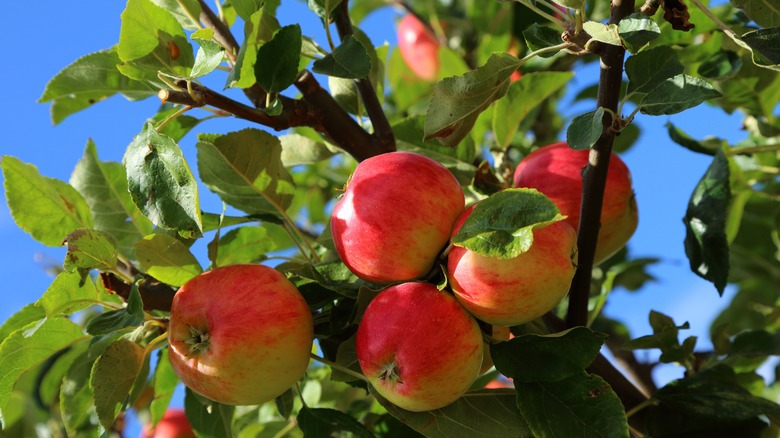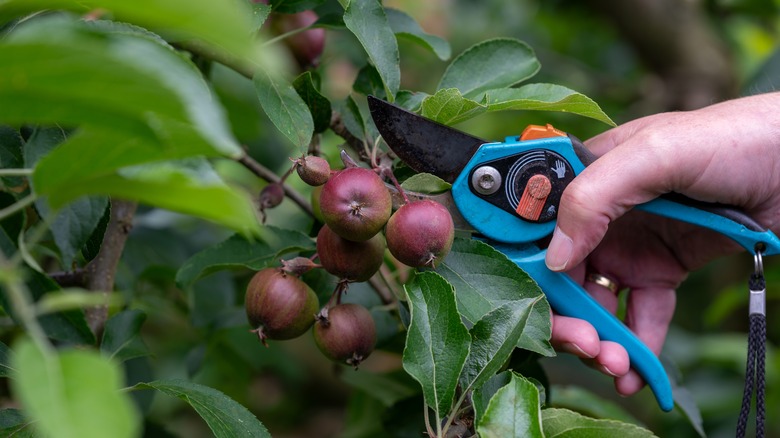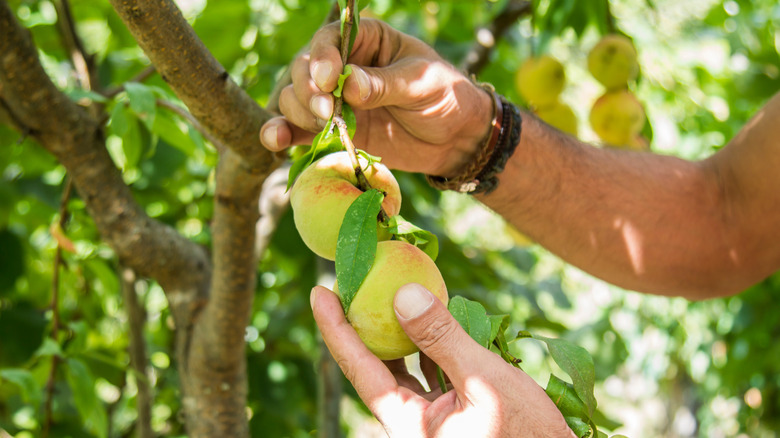What To Do If A Tree's Fruit Is Too Heavy For Its Branches
Are you worried that overweight fruits may wreak havoc on your orchard? Your concerns are justified — a tree's limbs face the risk of breaking as the fruits they bear get larger and heavier. Some trees protect their branches from this type of damage by shedding a portion of their fruits before they reach their peak size. "Fruit thinning" is a practice that mimics this natural phenomenon and involves manually plucking some of the crop while it's young. By thinning your orchard's crop loads properly and at the right time, you can reduce the amount of weight on the branches, and prevent them from breaking.
Fruit thinning has several other benefits apart from protecting a tree's limbs from heavy crops. The practice also prevents overbearing, which occurs when a tree produces too much fruit in one season, and none the next. Finally, thinning helps the remaining fruits reach their peak size before ripening, so you don't end up with too much fruit that's smaller than it needs to be. So, even though you'll feel like you're undermining the crops, thinning actually helps fruit trees bring a bountiful harvest to your yard. Here is how to thin the fruits in your orchards properly, and the specific requirements for apples, pears, and various stone fruit trees.
Fruit thinning for apples and pears
Thinning requirements are similar for apples and pears. With apples, you should aim to have a single fruit for every half-foot of branch. In practical terms, this means leaving one fruit on every spur (that's the stem on which the tree's blooms appear). With pears, you should leave two fruits every 6 inches on the branch instead of one. In the end, you'll be left with plenty of spurs that don't have fruit on them, and that's fine — you're doing your tree a big favor by thinning out its crops.
Another thing to consider is the size of fruit that gets thinned or left to ripen. It may sound unfair, but fruit thinning is all about the survival of the fittest. This means that you need to leave the biggest fruit and condemn its smaller peers to an early demise. Likewise, don't feel too bad about removing misshapen fruits, or those with obvious signs of illness.
It's best to thin apples and pears early in the season, while the fruits still measure about an inch in diameter — they usually get to this size about three weeks after the blooms disappear. You can thin manually by holding the fruit between the thumb and forefinger and plucking it off the tree. Alternatively, you can use shears or scissors to cut the fruit off. In either scenario, take great care not to damage the spurs. Spurs that survive this procedure will continue to bear flowers and fruits for seasons to come.
Fruit thinning techniques for stone fruit
Thinning is a different procedure for fruits like cherries, apricots, plums, and peaches. Firstly, the fruit grows on hardened wood, not spurs. Also, cherries, plums, and peaches drop some fruit on their own, usually at the end of spring or in early summer, in an effort to lighten the load on the branches. With this in mind, you shouldn't thin them as thoroughly. Instead, leave more fruit on the tree, and it will decide which ones to drop.
To make sure your plum produces fruit without breaking the limbs, thin to a pair of fruits every 6 inches or so on the branch, or a single fruit every 3 inches. Meanwhile, the ideal post-thinning distance between nectarines is 6 inches. On the other hand, peaches can be thinned more aggressively, and you shouldn't leave more than a single fruit for every 10 inches on a branch. When thinning peaches, resist the temptation to knock the fruit down by hitting the branches, as this practice produces less discriminate results. Instead, stick with manual thinning and cut or pluck the peaches from the branches. If you have apricot trees, you may not need to remove excess fruit at all. Of all stone fruit, apricots are the least vulnerable to bearing too much crop. If you find the branches are burdened by the crops' weight, thinning may be a good idea. In this case, leave 3 inches between fruits as you thin. Learn more about growing peach trees successfully.


